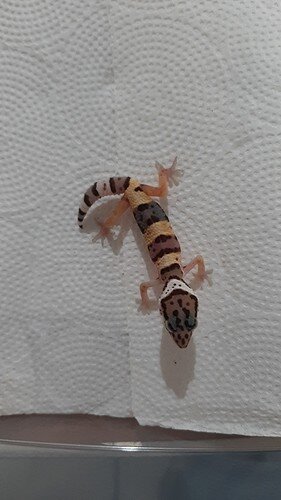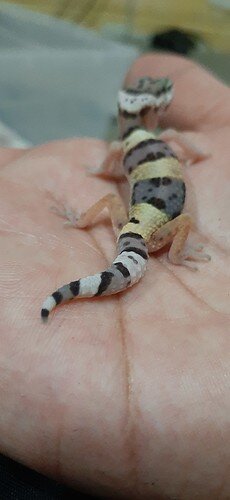I see a problem in his tail like a deformity, how do you see this leopard gecko? only has 3 months. Do you think this could be a problem in the future?
It could be a possible problem in the future, But if you are selling it MUST be a pet only.
@mblaney can help
@erie-herps and @mblaney may be of use. 
Looks like a kink.
Wonder if something spinal like twisted spine?
(I’ve only seen in Cresties though so we shall see what the experts in Leo’s say!)
I agree that it looks like a spinal kink where the spine meets the tail, if you really want to know a radiograph could show it (I think, @mblaney would know better). As @godzillao4 said, he shouldn’t be bred and should be sold as a pet only so the problem isn’t passed onto offspring and he isn’t harmed.
He could have problems in the future with impaction or passing poop/urates, he could also have a problem with hemipenes, only time will tell. It shouldn’t be a huge problem since it’s a relatively small kink.
Cute little fellow!! What everyone has said is right- don’t breed this gecko and sell it as ‘Pet Only’ (withhold its genetics so that no one will disingenuously purchase it to breed it).
Many people claim kinks are solely the result of incubator temperature fluctuations. While I think temp changes can sometimes cause issues, I don’t think it’s the case anywhere near as often as is claimed. Thus, I would (personally) not breed this gecko ever, and never breed it’s dam and sire together again. I would also take note of the bloodlines that resulted in this and consider avoiding similar pairings in the future. Most others would disagree, but since there are so many 100% healthy leos out there, there’s no excuse for taking chances, in my opinion.
From a health standpoint- if this gecko is female, it may encounter problems laying eggs (female leos that have not been bred can still lay dud eggs occasionally). Any owner you give this to should know that they are taking in an animal that may require surgery for egg binding at a later date, if it is female. It is also likely to develop a bit more arthritis with age.
A herp vet could possibly take radiographs and speculate as to the medical significance of the abnormalities. In mammals, radiographs of the abdomen can lose a lot of detail in babies, and I don’t know if there’s a similar phenomenon with the coelom of baby reptiles. Since baby geckos are so small anyway, it might be wisest to wait until it’s a bit older before doing imaging, unless your herp vet can use dental radiography equipment to get more detailed/small images or some other equivalent.
There’s no reason to euthanize this gecko, it can almost certainly have a good life. I have 2 tips (and they are kinda hot takes):
-
Once old enough, I recommend having an experienced herp vet do a proactive ovariectomy- leaving the uterus behind, intact, but removing both ovaries. My reasoning is that I believe this gecko may be more prone to developing egg dystocia because of its deformity, and it is a LOT safer, faster, and more successful to do the surgery as a preventative measure, than to do it when a gecko is very ill from egg binding. The uterus should be left behind in case the vet misses any follicles and they develop into eggs.
-
I suggest discussing with your herp vet what joint supplements would be appropriate to start giving this gecko once it’s older. Dosage is not the same as a dog or cat, and some can be overdosed, so make sure your vet is specific. Products I have used in different contexts (and very very small amounts) include Glycoflex and omega 3 fish oil.


